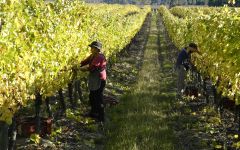Vina San Pedro Sideral 2017
-
James
Suckling - Decanter




Product Details
Your Rating
Somm Note
Winemaker Notes
Deep ruby with intense aromas of ripe red fruit, like cherries and black fruit such as blackcurrants intermingled with light notes of cedar. This wine is fresh and juicy with a good acidity, very well-rounded and structured tannins and a long velvety finish.
Blend: Cabernet Sauvignon 81%, Syrah 12%, Petit Verdot 3%, Cabernet Franc 2% & Carmenere 2%
Professional Ratings
-
James Suckling
There’s freshness and concentration here that really delivers a well proportioned and deeply juicy feel on the palate with a sleek, juicy, rich and smooth build to the fresh, long finish. A blend of cabernet sauvignon, syrah, carmenere, cabernet franc and petit verdot. Drink or hold.
-
Decanter
A lovely example of a red blend wine with a very expressive nose, berries, mint, eucalyptus and graphite. A cut above, with great purity on the finish.
Other Vintages
2016-
James
Suckling
-
James
Suckling -
Robert
Parker







Vina San Pedro was founded in 1865 in the Curico Valley by the Correa brothers. Today, more than 150 years later, it's still San Pedro's home valley. The brothers were pioneers in bringing different varieties from the Old Continent to the Valley.
San Pedro is now one of the most important vineyards in Chile and one of the top exporters, present in more than 80 countries around the world.
Also, San Pedro's Cachapoal Andes winery, home to the finest wines, is a place to discover the highest expression of Chileís diverse terroirs. Here, wines likes Altair, Cabo de Hornos and Sideral are made.
The Cachapoal Andes winery is located 110 km south of the city of Santiago, with vineyards at the foot of the Andes. Planted 500 meters above sea level, the vines are exposed to wide temperature variations between day and night, a peculiarity that allows the fruit to mature slowly, resulting in grapes with improved acidity, tannins, flavors, and aromatic profiles.

With hundreds of red grape varieties to choose from, winemakers have the freedom to create a virtually endless assortment of blended red wines. In many European regions, strict laws are in place determining the set of varieties that may be used, but in the New World, experimentation is permitted and encouraged resulting in a wide variety of red wine styles. Blending can be utilized to enhance balance or create complexity, lending different layers of flavors and aromas. For example, a red wine blend variety that creates a fruity and full-bodied wine would do well combined with one that is naturally high in acidity and tannins. Sometimes small amounts of a particular variety are added to boost color or aromatics. Blending can take place before or after fermentation, with the latter, more popular option giving more control to the winemaker over the final qualities of the wine.
How to Serve Red Wine
A common piece of advice is to serve red wine at “room temperature,” but this suggestion is imprecise. After all, room temperature in January is likely to be quite different than in August, even considering the possible effect of central heating and air conditioning systems. The proper temperature to aim for is 55° F to 60° F for lighter-bodied reds and 60° F to 65° F for fuller-bodied wines.
How Long Does Red Wine Last?
Once opened and re-corked, a bottle stored in a cool, dark environment (like your fridge) will stay fresh and nicely drinkable for a day or two. There are products available that can extend that period by a couple of days. As for unopened bottles, optimal storage means keeping them on their sides in a moderately humid environment at about 57° F. Red wines stored in this manner will stay good – and possibly improve – for anywhere from one year to multiple decades. Assessing how long to hold on to a bottle is a complicated science. If you are planning long-term storage of your reds, seek the advice of a wine professional.

Well-regarded for intense and exceptionally high quality red wines, the Colchagua Valley is situated in the southern part of Chile’s Rapel Valley, with many of the best vineyards lying in the foothills of the Coastal Range.
Heavy French investment and cutting-edge technology in both the vineyard and the winery has been a boon to the local viticultural industry, which already laid claim to ancient vines and a textbook Mediterranean climate.
The warm, dry growing season in the Colchagua Valley favors robust reds made from Cabernet Sauvignon, Carmenère, Malbec and Syrah—in fact, some of Chile’s very best are made here. A small amount of good white wine is produced from Chardonnay and Sauvignon Blanc.
